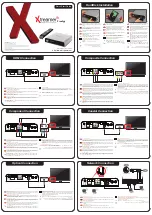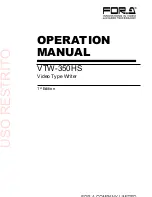
Page 20 Non-Sound Decoder MX618 - MX634 and Sound Decoder MX640 - MX648
3.8 Spe
cial Operating Mode “km/h – speed regulation
“
The km/h speed regulation is an alternative method of driving with prototypical speeds in all operating
situations: the cab’s speed steps (1 to 126 in the so-called “128 speed step mode”) will be directly in-
terpreted as km/h.
However, ZIMO decoders do not simply convert the speed steps to a km/h scale but rather ensure
that the desired speed is held, by recalculating the already traveled distance and automatically make
the necessary adjustments.
A CALIBRATION RUN must be performed with each engine:
First, we need to determine the
calibration distance:
a section of track that measures 100 scale me-
ters (plus the necessary acceleration and deceleration distances before and after), of course without
inclines, tight radii and other obstacles; for example, for HO (1:87) 115cm; for G-scale (1:22.5) 4.5m.
Mark the start and end points of the calibration section.
Set the engine on the track, with the proper travel direction selected, about 1 to 2 meters before
the start marker and the function F0 (headlights)
turned off.
Acceleration times (in CV #3 of the de-
coder as well as settings in the cab) should be set to 0 or a very small value.
Start the calibration mode by programming
CV #135 = 1
(operations mode programming). This is a
pseudo-programming because the value of 1 does not replace the value already stored in CV #135.
Move the speed regulator to a
medium speed
position (1/3 to ½ of full speed); the loco acceler-
ates towards the start marker
As the engine passes the
start marker,
turn on
the function
F0
(headlights);
turn F0 off
again
when passing by the
end marker.
This ends the calibration run and the loco may be stopped.
CV #136 can now be read out for checking purposes. The calibration “result” stored in that CV
doesn’t mean very much by itself. If however, several calibration runs are performed, the value in CV
#136 should approximately be the same every time, even if the traveling speed was different.
Km/h speed regulation in operation:
CV #135
defines whether the “normal” or km/h operating mode is in use:
CV #135 = 0: The engine is controll
ed in “normal” mode; a possible km/h calibration run performed
earlier has no effect but the calibration results remain stored in CV #136.
CV #135 = 10, 20 or 5: each external speed step (1 to 126) becomes
1 km/h, 2 km/h or 0.5 km/h: see CV table below!
The speed regulation in km/h is not just useful for direct throttle control, but also for speed limits
through the “signal controlled speed influence” (CV’s 51 – 55). The values entered to those CV’s are
also being interpreted in km/h.
CV
Designation
Range
Default
Description
#135
Km/h
–
Speed regulation -
2 - 20
0
= 0: km/h
– Regulation turned off; the “normal”
speed regulation is in effect.
Activation, control and
range
definition
NOT applicable to
MX621
Pseudo-Programming:
CV #135 = 1
Initiates a calibration run (see above)
Continue with “normal“ programming:
= 10: each step (1 to 126) represents 1 km/h: so
step 1 = 1 km/h,
step 2 =
2 km/h, step 3 = 3 km/h…
= 20: each step represents 2 km/h;
step 1 = 2 km/h, step 2 = 4 km/h,
last step 126 = 252 km/h.
= 5: each step represents 0
.
5 km/h;
step 1 =
.
5 km/h, step 2 = 1 km/h,
last step 126 = 63 km/h.
#136
Km/h
–
Speed regulation -
Control number read-out
or
adjustment for speed
confirmation
CALIBRA-
TION RUN
or
RailCom
display
factor
Read
only
128
A numeric value can be read-out after a successful cali-
bration run, which was used to calculate the speed. It
should remain unchanged (or vary only slightly) even af-
ter multiple calibration runs.
or
correction factor for speed confirmation via RailCom or
other method of bidirectional communication.
Mph instead of km/h:
Extending the calibration distance accordingly results in a mph speed regulation!
3.9
The ZIMO “signal controlled speed influence” (HLU)
ZIMO digital systems offer a second level of communication for transmitting data to vehicles in specific track
sections
. The most common application for this is the “signal controlled speed influence” for stopping trains
and applying speed limits in 5 stages, with data sent to the track sections as needed in the form of HLU cut-
outs prepared by MX9 track section modules or its successors. This feature only operates within ZIMO sys-
tems.
The speed limits “U”(Ultra low) and “L” (Low speed) as well as the intermediate limits of the “signal controlled
speed in
fluence” can be defined with configuration variables #51 to #55 as well as the acceleration and de-
celeration values (momentum) with CV #49 and #50.
Please note that the signal controlled acceleration and deceleration times in CV #49 and #50 are always
added
to the times and curves programmed to CV #3, 4, 121, 122 etc. Signal controlled accelerations and
decelerations compared to cab controlled momentum can therefore only progress either at the same rate (if
CV #49 and #50 is not used) or slower (if CV #49 and/or #50 contain a value of >0), but never faster.
It is of utmost importance for a flawlessly working train control system using the signal controlled speed in-
fluence that the stop and related brake section lengths are arranged properly and consistently everywhere
on the layout. Please consult the MX9 instruction manual.
The
deceleration (often CV #52 for “U” limit) and brake (CV #4 and #50) characteristics should be set so that
all locos come to a complete stop within about 2/3 of the stop section, which in HO is typically about 15 to 20
cm before the end of a stop section. Setting the loco up to stop precisely within the last centimeter of a stop
section is not recommended.
















































